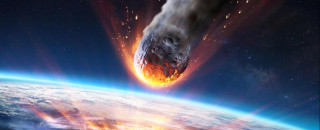Science Writer Riley Black Illuminates the Day that Changed Life on Earth Forever
By Jim Breitinger
NHMU science writer and author Riley Black’s new book The Last Days of the Dinosaurs is a stunning achievement in explaining a pivotal event in the history of our planet. On what she describes as the worst day in history–at least for dinosaurs and Late Cretaceous life of all kinds–Black takes the reader on an unforgettable journey into one of Earth’s most dramatic moments, when a six-mile-wide asteroid crashed into Earth in the region of today's Yucatan Peninsula.
Black focuses like a laser on the moment when the Cretaceous came to a shocking and sudden end. But she does far more than this. She engagingly brings to life the complex lost ecosystems of the late Cretaceous and the subsequent time period, the Paleogene, when mammals began to thrive. With a creative narrative voice she mines the rich field of modern paleontology introducing readers to countless species that made up the ecosystems of our planet between 66 and 65 million years ago.
While NHMU can showcase key creatures from past ecosystems in our memorable exhibits, Black goes far deeper in her book-length narrative and explains the world that existed, discusses how it was destroyed, and sheds light on the new one that emerged which eventually led to our world today. It was that event so many millions of years ago that would eventually allow Homo sapiens to emerge, something that wouldn’t have happened the way that it did without that terrible impact.
The Cretaceous-ending asteroid nearly ended life on Earth. Photosynthesis almost ground to a halt preventing the growth of plants, a key fuel for living creatures. Tsunamis swept hundreds of miles inland. Fires scorched the planet in something worse than one of the worst nuclear wars imaginable. The fact that life persisted at all is a wonder and it’s a wonder that Black eloquently explains in accessible and beautiful writing.
For many years NHMU has benefited from the writing and field work of the amazing Riley Black. We strongly recommend her latest literary achievement as a way to further educate yourself on past ecosystems and to deepen your understanding of our natural world.
Jim Breitinger served as the director of marketing at the Natural History Museum of Utah, a part of the University of Utah in Salt Lake City. Our mission is to illuminate the natural world and the place of humans within it. In addition to housing outstanding exhibits for the public, NHMU is a research museum. Learn more.
